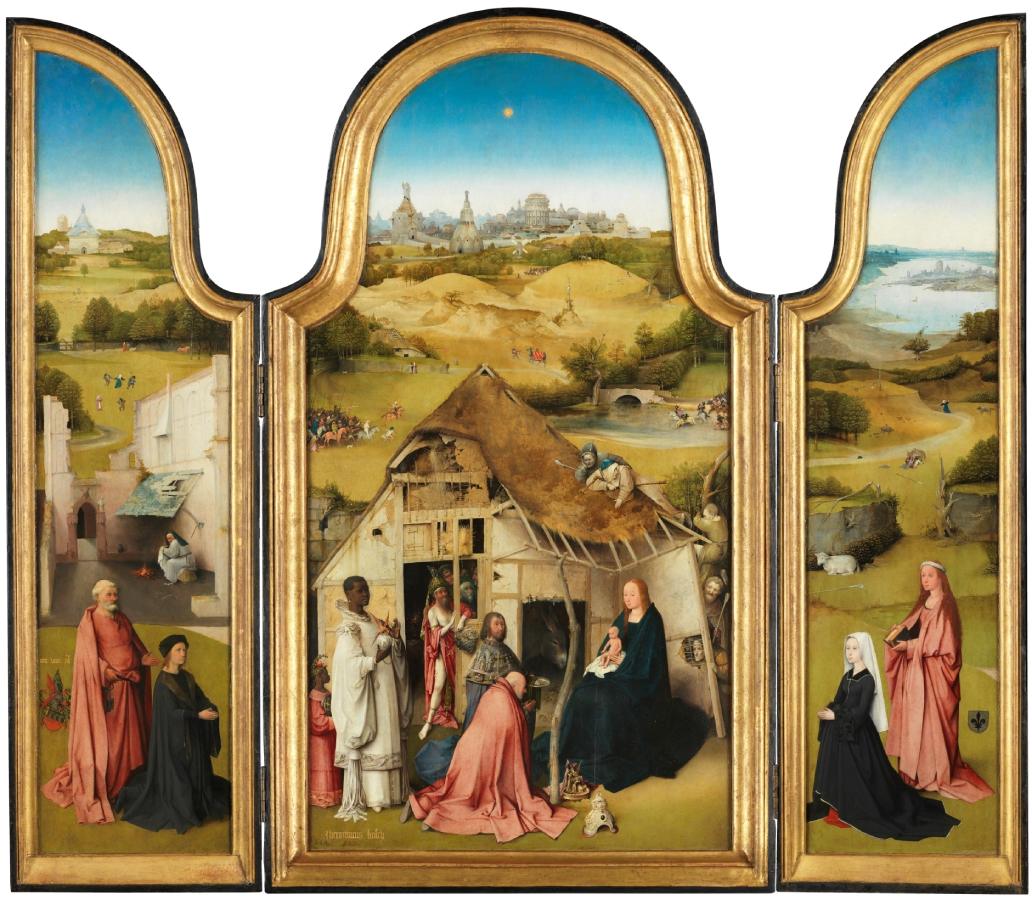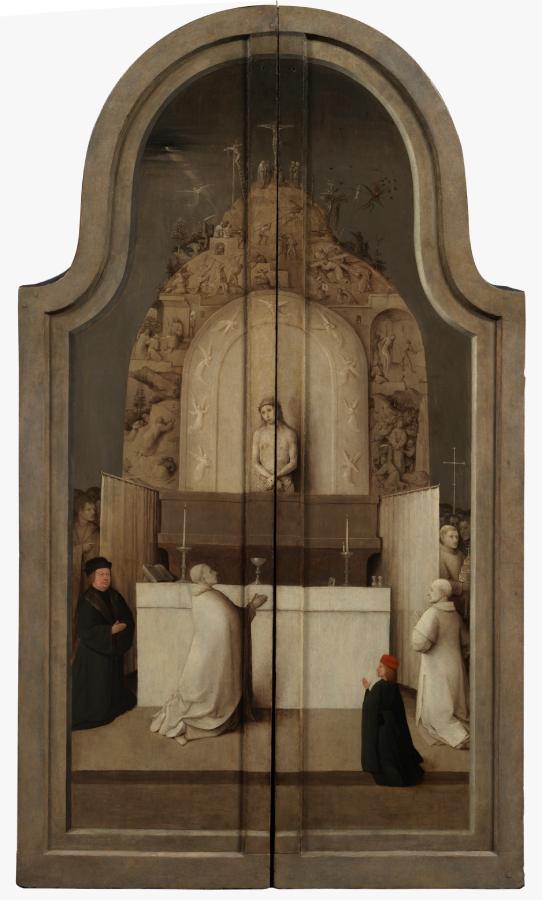Bosch, Hieronymus (c.1450-1516)
Adoration of the Magi
c.1494
Oil on oak panel, 147.4 x 168.6 cm
Museo del Prado, Madrid
Closed:
The theme of this triptych is the advent of salvation -a message about the universality of Redemption. The Eucharistic meaning inherent in the theme of Saint Gregory’s Mass is also found in The Adoration of the Magi in the wheat stored in the upper part of the hut, above the figure of the Antichrist. Unusually, Bosch includes in his depiction of the Mass of Saint Gregory in semi-grisaille seven Passion scenes, culminating in the upper part with the Crucifixion on Mount Calvary, marking the consummation of the Redemption. Bosch arranges these scenes in tiers in the manner of an altarpiece, on either side of the risen Christ. From bottom to top and left to right, they represent: the Agony in the Garden, Christ’s Arrest, Christ before Pilate (whose wife peers out from behind the canopy), the Flagellation, the Crowning with Thorns, the Way to Calvary and the Crucifixion. The last scene -Christ on the cross and five accompanying figures, separated from the rest- is painted on the frame. The Good Thief is already on the cross on the Redeemer’s right, with an angel beside him, while the Bad Thief waits for his cross to be erected on Christ’s left. Nearby Judas can be seen hanging from a tree, as demons carry away his soul. Another unusual feature is the nine angels who surround the figure of Christ as the Man of Sorrows emerging from the sarcophagus, also painted on the frame. Nor is it common to find curtains separating the background figures on either side from those in the foreground where the miracle occurs -the pope and the priest who assists him at the Mass and the donors who receive the fruits of Redemption. Bosch added these curtains during the final stage of execution, painting them over the already completed figures. Although scholars have wished to believe that he added the donors some time after completing the work, the technical studies prove that he painted donors and work at the same time.
The open triptych shows Mary holding Jesus on her lap in a manner that recalls the works of Jan van Eyck (c. 1390-1441). The left wing shows Peeter Scheyfve protected by Saint Peter and with his motto Een voert al (One for all) and the right wing features his second wife Agneese de Gramme protected by Saint Agnes. A further two donors are included on the reverse, which depicts the Mass of Saint Gregory in semi-grisaille. The young man is the patrons’ son Jan Scheyfve and the old man is probably Peeter’s father Claus Scheyfve, who died before 1495, members of Antwerp’s wealthy burgher class.
The Magi’s gifts and clothing are decorated with the Old Testament scenes that prefigure the Adoration of the Magi in the Biblia pauperum. Bosch demonstrates his painting skills in the opulence of the Magi’s robes and offerings -in the sumptuous of the materials and his masterly application of highlights in brushstrokes so fine that they appear to be drawn, for example in the scene of the Sacrifice of Isaac on one of the gifts. The gift the first Magus has placed at the Virgin’s feet, beside his sumptuous helmet, is a table ornament made of gold and pearls. It is decorated with a scene of Sacrifice of Isaac, which prefigures that of Christ himself on the cross; this idea is reinforced by the fact that it rests on toads, which allude to sin. The upper part of the metal cloak worn by the second Magus, who offers the Child myrrh on a silver tray, is decorated with one the themes that the Biblia pauperum associates with the Adoration of the Magi, the Queen of Sheba presenting her gifts to Solomon (1 Kings 10: 1-13). Depicted below this scene is the offering made by Manoah and his wife after God’s announcement that they will have a son, Samson (Judges 13: 19-23), which likewise prefigures the birth of Christ. The third Magus’s gift, which he holds, is a spherical vessel containing incense. It is decorated with Abner kneeling before King David offering to instruct the tribes of northern Israel to join those of the kingdom of Judah (2 Samuel 3: 10) -a scene which prefigures the Adoration of the Magi in the Biblia pauperum along with that of the Queen of Sheba. The phoenix perched on the vessel, gathering grain in its beak, evokes the Resurrection of Christ. It should be stressed in connection with this third Magus that, in addition to the border of his white cloak, the thistle leaves adorning the shoulders and neck allude to the Passion of Christ and, accordingly, the Redemption. Also worthy of note is the border along the lower edge of the black page’s tunic, which displays the motif of big fish eating little fish. Painted on without underdrawing, it should be interpreted in the context of the salvation theme that pervades the whole triptych. The Antichrist at the entrance to the stable -which resembles a Brabantian hut- wears a cloak that barely covers his body and beneath it a transparent veil. Proof of the evil nature of this figure is the owl concealed above him in the upper part of the hayloft gazing at the dead mouse that has become its prey. His evil appearance is emphasized by the people beside him inside the hut, among them a woman reminiscent of Leonardo’s caricatures in a headdress like those of some of the demons Bosch painted, whose deformed features take on a hideous expression. The six shepherds on the far right, who traditionally represent the Jewish people, complete the scene of the Adoration of the Child. On the left of the background landscape behind the hut, Bosch painted a house whose flag with a swan and the dovecote above identify it as a brothel. A man pulling a tethered horse ridden by a monkey, an allusion to lust, is heading in its direction. Lower down two armies of men on horseback, deployed on the left and right, ride towards each other. On the basis of their oriental headdresses they have been identified as Herod’s soldiers seeking out Jesus to kill him. The city silhouetted against the clouds in the background is Bethlehem. Although here the painter is carried away by his imagination and his buildings have an oriental appearance, there is also a windmill outside its walls, and beside it a third group of horsemen.
The underdrawing, executed with a brush and a liquid medium, shows that Bosch made a few changes and alterations to the position and contours of some elements when he painted his masterpiece. In general, he used long, thin, light strokes to sketch the main elements of the composition, though some are thicker. In the areas with modelling and in some details his strokes are shorter, but always adapted to the size of the motif. The folds of the drapes are drawn with long strokes in a less intense colour. Creases and areas of shadow were often further accentuated during the paint stage.
Silva, Pilar, ‘El Bosco. Tríptico de la Adoración de los Magos’ En:. El Bosco. La exposición del V Centenario, Madrid, Museo Nacional del Prado, 2016, p.n.10 195-207.

